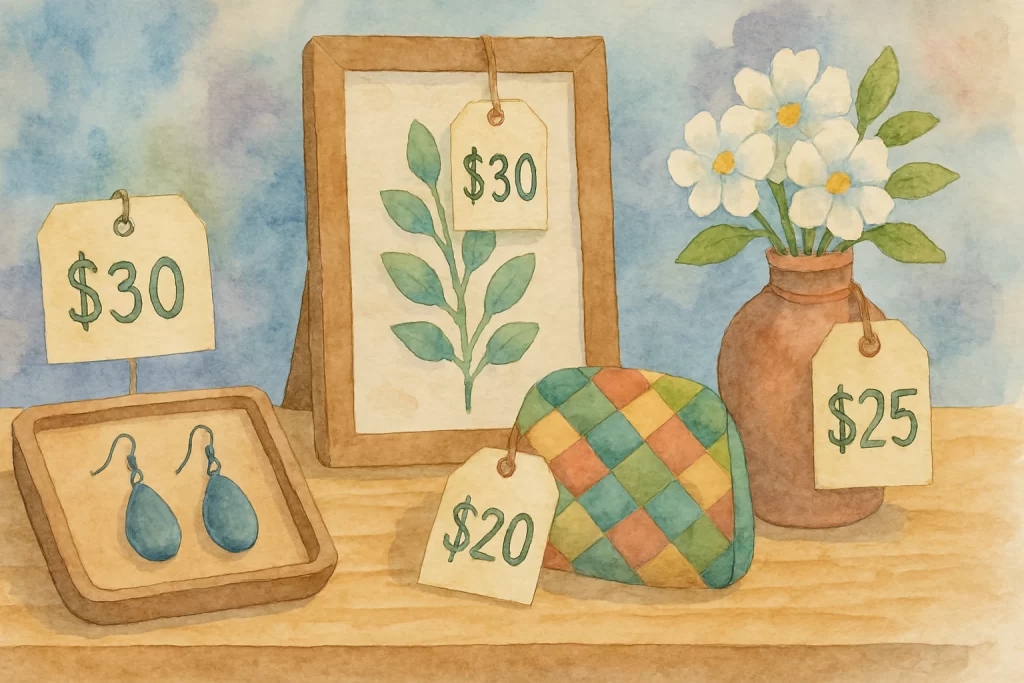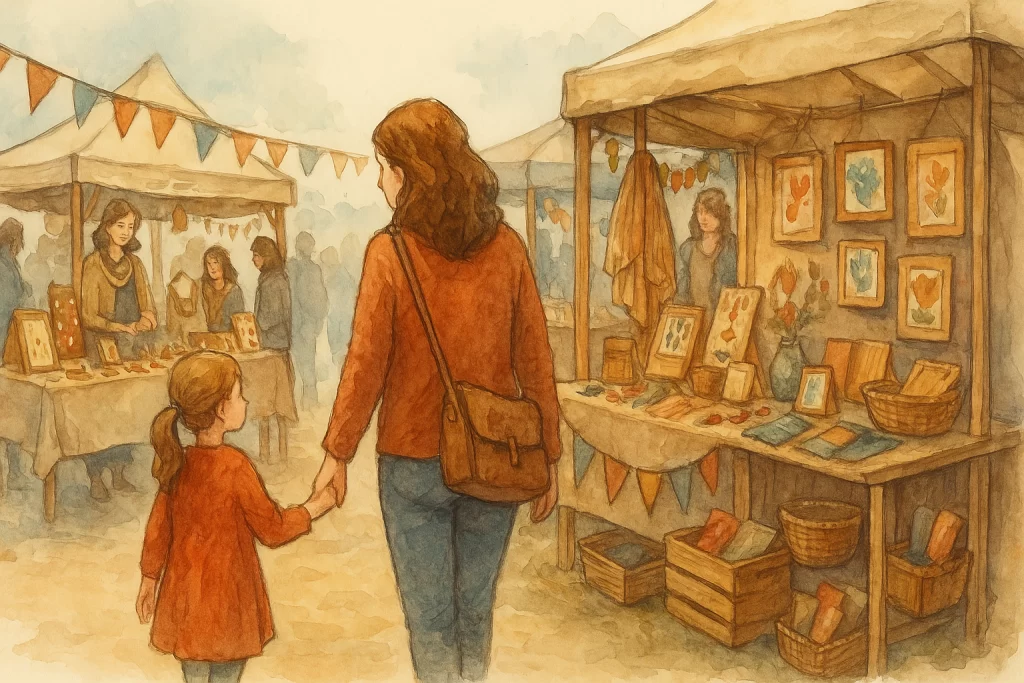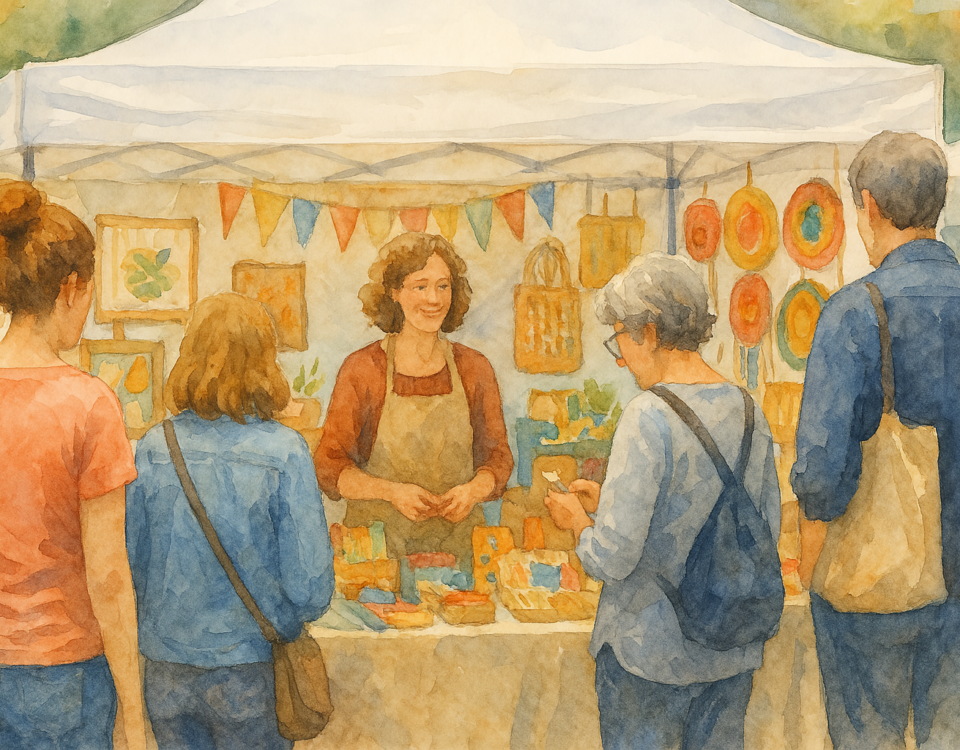Impulse Shopping Is Driving Sales at Craft Fairs (But Only If You Do This)
Key Takeaways
- Customers decide in 3–5 seconds whether to enter your booth—visual design is critical.
- Impulse shopping is often triggered by sensory experiences, storytelling, and social influence.
- Live demos, limited-time offers, and emotionally rich product stories can increase sales fast.
- Parents are especially prone to emotional and time-based impulse buying at craft fairs.
- Smart booth layout, varied pricing, and small personalization touches can boost engagement.
- Social media plays a huge role in building trust and triggering FOMO in real-time.
- Your customer wants to meet the maker—don’t underestimate personal interaction.
- Kids influence buying decisions more than you think.
Booths That Pop: How Visual Appeal Triggers Impulse Shopping
What makes someone stop and look at your table instead of the one next to it?
It’s not just the stuff you’re selling. It’s how your booth feels. It’s layout. Color. Light. Shape. Height. Chaos or calm. It’s all the stuff we don’t say out loud—but our brains clock it immediately.
Impulse shopping starts here.
Literally, it starts the moment someone’s eyeballs skim your setup. If your table looks meh, they keep walking. If it looks good, their body slows. If it looks really good, they stop. Boom—you’ve got a window to connect.
Here’s what matters (and what doesn’t):
| Factor | Why It Works | How to Do It |
|---|---|---|
| Rule of Thirds | Helps display feel balanced + easy to scan | Divide booth visually into left/mid/right zones |
| Vary Heights | Adds interest, draws eyes to multiple levels | Use crates, risers, upside-down baskets |
| Color Psychology | Evokes emotion—warmer = friendlier | Stick to 2-3 colors that match your vibe |
| Lighting | Makes product look better—even outdoors | Clip-on LED lights, fairy lights, battery spots |
| Tablecloths | Hides ugly legs, gives cohesion | Solid colors, no cluttered patterns |
Why parents respond to visuals even more
Parents are tired. They’re juggling snacks, strollers, kids asking for lemonade. They don’t have time to “think through” each booth. So if yours makes them feel something nice fast? They’ll stop. You’ve already won half the battle. Clean layout = less decision fatigue.
And impulse shopping thrives on that exact thing—low mental effort. They saw it, they liked it, they bought it. Done.
Stories Sell: Why a Personal Backstory Boosts Sales
Let’s be honest—people don’t just buy the thing. They buy the why.
You might be selling soy candles, wood carvings, little handmade monster dolls. But what they’re really buying is a story: about who made it, why, how, what it means.
If your stuff doesn’t have a story? It’s just stuff.
And stuff without story doesn’t stick. It doesn’t move hearts. It doesn’t make impulse shopping happen.
Why stories make people spend money faster
Because stories short-circuit the logical part of the brain.
They speak to emotion. That feeling of “Oh, that’s so sweet,” or “Wow, this person put their heart into it,” is often enough to nudge someone from browsing to buying.
Here’s the wild thing:
According to the American Craft Council, items with clear stories behind them sell at up to 23% higher prices than the exact same items without a backstory. That’s not fluff. That’s real psychology. And it works.
Ways to tell a story without writing a novel
You don’t need a whole essay at your booth. Just enough to plant a seed.
Quick storytelling wins:
- Tagline signs: “Inspired by my late grandma’s garden” → simple, human, emotional.
- Tiny product cards: “Each one hand-carved from recycled fence posts.”
- Verbal explanation: When a customer asks, “What made you start doing this?” be ready with a short and real answer.
- Photos: Behind-the-scenes pics taped to the table. Or a sign: “Meet the Maker: Jess, full-time mom, part-time clay sculptor.”
Parents connect to real-life hustle
Especially parents who are also side-hustling. Or who just dragged their toddler to this fair while trying not to spill coffee.
When they hear you’re a mom, too? Or that you started this business during nap times? That builds trust, fast. You’re not a company. You’re a person. That makes buying feel good. Like supporting a friend, not a brand.
And that emotional hook is the soil impulse shopping grows in.
If someone connects with your story, they don’t need more reasons. They already want to buy.
Pricing Psychology: How to Tap Into Perceived Value
Let’s talk about money. And how weird our brains are about it.
You’d think people just look at a price tag and decide if they can afford it, right? Nah. That’s not how impulse shopping works. Pricing is about feel, not just logic. If the number feels right—if it tells the right story—people will pay it. Sometimes even happily.
So the way you present your prices matters just as much as the actual number.
People don’t do math. They do vibes.
Ever see $19.95 instead of $20 and think: “Hey, that’s a better deal!”
That’s called charm pricing. It’s been used forever because it works. That five-cent difference makes the price feel more approachable. More human. Like someone thought about it instead of slapping on a round number.
Now imagine you have three price tiers:
- $5 bookmarks
- $20 journals
- $60 handmade leather sketchbooks
That’s called tiered pricing. Also psychological gold. The $60 item makes the $20 one feel like a steal. And the $5 one? A guilt-free “treat yourself” moment. You’re not just selling a product—you’re building a ladder of value.
Bundles make brains go “Yes, that’s a deal”
Bundling is like telling people they’re getting something extra… even if you added nothing new.
Example: Two soaps = $12, but together for $10? Boom—instant reward center activation.
Impulse shopping loves bundles. It feels smart. Like you’re beating the system, even when you’re not.
You can bundle stuff people already want:
- Two candles + a wick trimmer
- Earring set + bonus velvet pouch
- Kid craft kit + sticker sheet
Make it feel like they got something “extra,” even if it’s just clever packaging.
What about price tags? Show them. Always.

A lot of new sellers make this mistake: hiding prices. Thinking it makes people more likely to ask. Spoiler—it doesn’t. It just makes them nervous and avoid your booth.
Shoppers—especially parents juggling kids—don’t want mystery. They want fast decisions. Clear prices help.
Even better? Try little stories next to your pricing signs:
- “This piece took 3 hours to carve.”
- “Made with organic beeswax from a farm 20 miles away.”
That’s perceived value. You’re not just justifying the price. You’re letting the customer feel the quality.
Parents need quick value signals
Parents don’t have time to second-guess. They’re mentally managing a schedule, snacks, and a stroller while scanning your table. If they see a price that feels fair, they’ll act on it. If they have to do mental math, or wonder if it’s worth it? They’ll probably walk.
The right price, shown the right way, makes impulse shopping feel like the smart choice.
Touch It, Try It, Love It: Sensory Engagement That Converts
Here’s the deal: online shopping doesn’t let you feel stuff. It’s all flat screens and fake lighting. Craft fairs? Different beast. They let people touch, smell, hold, try, squish, crinkle, tap, sniff, flip—and yeah, that kind of freedom sells.
And when people are using their senses, they’re using a different part of their brain. Less logic. More gut. That’s when impulse shopping kicks in hard.
You touch it? You want it.
It’s not magic. It’s called the endowment effect—once someone handles something, they start to feel like they own it. Even for 10 seconds. That shift? It makes putting it back down feel like a loss.
So give people permission to handle your stuff. Literally say it out loud:
“Feel free to pick things up.”
“Want to try this on?”
“Smells good, right? It’s lemongrass!”
Encouraging that sensory moment triggers a mini connection. Suddenly, it’s not a candle. It’s their candle. Game over.
Live demonstrations = traffic magnets
Craft fairs that include demos get way more engagement. Like 67% more according to the data. People want to see how things are made. It builds trust. Shows skill. Plus—it just looks cool.
Even small demos work:
- Stirring a pot of wax
- Threading a bracelet live
- Sketching quick illustrations
- Pressing soap molds in front of people
Keep it simple. Repeatable. Predictable. Bonus if it makes noise or smells good. People walking by hear it, smell it, glance over—and now they’re standing in front of your booth, watching. Then buying.
Let them do it themselves (even a little)
Want kids to beg their parents to buy? Let them make part of it.
Mini-experiences like these can pull people in:
- Stamp your own bookmark
- Pick your own candle label
- Choose your crystal for a “custom” bracelet
Parents will pay to let their kid feel like they “made” something.
The five senses cheat sheet
| Sense | How to Use It | Example |
|---|---|---|
| Touch | Let people hold or wear items | “Try it on!” or “Feel the texture!” |
| Sight | Use movement, sparkle, contrast | Hanging mobiles, shiny earrings that sway, watercolors |
| Smell | Use scents to draw people in | Candles, soaps, essential oil rollers |
| Sound | Soft music or gentle sounds from demos | Wood carving? Let the tapping be heard |
| Taste | (if food) offer samples | Jam, bread, spice blends—little paper cups go a long way |
Parents crave calm, too
If you’re selling anything that soothes—lavender oils, calming tea blends, smooth ceramics—lean into it. Invite them to touch, breathe, feel.
That little moment might be the only calm they get all day. And if they associate your product with that feeling? They’ll want to buy it. That’s classic impulse shopping. And it works.
FOMO and Feeds: Social Proof and Digital-Driven Impulse Shopping
Most shoppers won’t admit it, but they’re watching what other people do. Always.
Someone’s holding a bag from your booth? You’ll get more visitors. Someone posts a photo of your earrings on Instagram? That might bring you 3 more buyers in the next hour.
Impulse shopping isn’t just triggered by stuff—it’s triggered by people buying stuff. That’s called social proof.
And it hits even harder when it’s happening in real time. In front of other people. At a craft fair. Surrounded by other shoppers wondering what they’re “missing.”
What is social proof, really?
It’s not hype. It’s brain science.
People feel safer making a purchase when they see someone else has already done it. It’s a shortcut. Instead of analyzing every product, the brain says:
“If other people are buying it… maybe I should too.”
This is where FOMO (Fear of Missing Out) slides in. And it can make or break your sales numbers in a few hours.
How to create your own social proof—on purpose
You don’t have to sit and hope someone posts about your booth. You can build the moment.
Here’s how:
- Event-specific hashtags
Print it. Display it. Say it. Make it easy. Example:#MadeAtMidtownMarketor#JessCraftsBoise - Ask people to tag you
It’s not awkward. Most people are cool with it. Try:
“If you post it, tag me—I’d love to see it on you later!” - Create photo-friendly spots
Add a small mirror with a handwritten sign:“Tag us @fireandthread for a surprise later!”
You can even tape up a mini sign: “Cute selfie spot.” - Offer small discounts or freebies for social shares
“Post and tag us for $2 off your next item.”
“Get a bonus keychain with every tagged story!”
Parents love a good brag moment
They will post a picture of their kid painting pottery. Or holding a glittery dinosaur soap. Or eating the cookie from your booth. That’s free content. Free reach. More eyeballs.
And it feeds the cycle:
- They post
- Someone sees it
- That person visits your booth
- They post
- Someone else sees it
Suddenly you’re not just a vendor—you’re a thing people want to be part of. That’s how impulse shopping turns into a ripple effect.
Scarcity Sells: Exclusivity and Urgency at Craft Fairs
Here’s something weird: people want things more when there’s less of them.
You’ve seen it happen. Someone picks something up. Then sees a sign that says “Last One.” Boom—decision made. That’s the scarcity effect. It taps into urgency. It turns impulse shopping into a now or never decision.
Craft fairs are the perfect place to use this because they’re temporary by nature. It’s not a store. It’s not online. It’s here for a few hours, maybe a day. So you don’t need to fake urgency. You just need to show people it exists.
Scarcity makes people stop thinking and start buying
It’s that internal dialogue:
“What if I come back later and it’s gone?”
“There’s only one of these left—someone else could grab it.”
“I don’t want to miss out on this thing I didn’t even know I wanted.”
That’s how impulse shopping happens. Not from logic. From loss aversion. The fear of missing out beats the desire to save money every single time.
How to create scarcity without being shady
Don’t lie. Don’t make up fake countdowns or pretend you only made two of something when you brought twenty.
Do this instead:
- Limited edition signs
“Only 6 made in this color.”
“Seasonal drop—won’t return till next spring.”
That’s real, and people respect it. - Real-time item count signs
“Only 3 left today!” (Cross off numbers as you sell them.)
This shows movement and lets shoppers feel the heat. - Time-based offers
“Free sticker with every purchase before 2pm.”
“Buy one, get one 50% off for the next hour.”
This forces fast decision-making—great for impulse shopping. - Handwritten “Just Sold” tags
Hang them on empty displays with a quick note:“Sold to Maya at 10:30am!”
Creates visual proof that people are buying.
Parents especially don’t want to miss out
They see their kid holding a toy, looking happy, and suddenly it’s a moment. Not buying it feels like ruining that moment.
Or they see someone else’s kid holding the “last” beaded wand. Boom. Urgency just turned into emotion. And once that hits? You’re not even selling anymore. You’re just handing over something they already decided was theirs.
Impulse shopping thrives when people feel like they have to decide fast. Craft fairs already have that baked in. Use it. Let the clock and the crowd work for you.
Meet the Maker: How Personal Interaction Builds Brand Loyalty
This one might sound obvious, but it’s not. It’s powerful. People want to know who made the thing they’re buying. Not just what it’s made of—but who, why, how long it took, what it means to them.
When someone meets you, not just your stuff, it changes everything. It’s harder to walk away. Easier to buy. And that’s where impulse shopping slides right in, quietly, without asking permission.
People don’t buy products. They buy people.
It’s real simple: if they like you, they’ll probably like your stuff.
Ever seen someone walk past 3 candle booths, then stop at the fourth just because the seller smiled first? Happens all the time. The product didn’t change. The energy did.
Talk to your customers. Not with a sales pitch. With a normal, human voice.
Say things like:
- “I just poured this one yesterday—it’s my favorite scent this week.”
- “These prints are based on parks I took my kids to when they were little.”
- “That one took me four hours. I kept restarting it ’cause the glaze wasn’t right.”
These aren’t selling points. They’re connection points.
Ask real questions. Give real answers.
You don’t need a script. You need curiosity.
Try this:
- “Looking for a gift or something for yourself?”
- “What kinds of stuff do your kids get into?”
- “Do you like bold colors or softer tones?”
- “Want to hear how I make these?”
People like being seen. When you see them—and tailor your suggestions to their vibe—it builds instant rapport. That’s the foundation for brand loyalty.
For parents, it’s even more personal
Here’s something that gets overlooked a lot: when parents shop, they’re not just shopping for themselves. They’re looking at every item like:
- Will my kid break this?
- Is this gift going to feel thoughtful enough?
- Can I carry this while pushing a stroller and holding a juice box?
So when you help them make decisions—when you get what they’re dealing with—you become more than a vendor. You become the person who “gets it.” That builds trust. Fast.
Little interactions = long-term results
Impulse shopping doesn’t always look like big dramatic purchases. Sometimes it’s a $6 magnet. Sometimes it’s “I’ll come back later,” and they actually do.
And sometimes, it turns into:
- Repeat buyers at your next fair
- Followers on your socials
- People recommending you to their sister-in-law
- Future online orders after they’ve gone home and thought about it
All because you smiled. Or made a joke. Or asked about their kid’s name.
People remember people. Be one worth remembering.
Why Parents Are Particularly Prone to Impulse Shopping at Craft Fairs

Here’s the thing: craft fairs don’t just sell crafts—they sell moments. And parents? They’re deep in the moment economy. Everything’s a memory, a potential meltdown, or a maybe-happy distraction. You know how it is.
Impulse shopping for parents isn’t random—it’s emotional, reactive, and often done in five seconds with one hand on a juice box. There are specific psychological patterns at play here, and understanding them can completely change how you approach selling.
So… why do parents impulse shop more than other people?
Let’s break it down. It’s not just stress, though that plays a part. It’s also:
- Decision fatigue
After a morning of wrangling toddlers, packing snacks, dodging tantrums, and getting everyone dressed, the brain is tired. Making one more decision—like “should I buy this?”—becomes too much. So they just do it. Easier. - Emotion-first thinking
Parents are walking around feeling things: pride, exhaustion, love, guilt, nostalgia. That’s a perfect recipe for buying something on the spot that feels like it’ll give them—or their kid—a quick joy hit. - “Treat culture”
You hear it all the time: “You’ve been so good today—want to pick something out?”
That moment becomes a mini reward ceremony. Even if it wasn’t planned. Especially if it wasn’t planned. - Urgency by schedule
A parent might only have 10 minutes before their kid melts. Or before a soccer game. Or before nap time. That time crunch? It pushes faster decisions. They don’t want to leave and regret not buying the thing.
5 classic parent-driven impulse shopping moments
Here are some real-life scenarios that sellers see every weekend:
- Kid spots a glittery slime jar. Immediately obsessed.
Parent’s brain: “Okay fine it’s five bucks and it keeps you quiet.” - Mom sees a sign that says “Made by moms for moms.”
Instant trust. She buys the candle. - Dad’s holding the diaper bag and sees a cute onesie with a joke on it.
Laughs. Buys it. Doesn’t ask the price. - Mom hears you say “It’s the last one.”
Buys it. Doesn’t even touch it first. - Both parents are tired, the kid is whining, and they just want to make the day feel like a win.
A $12 handmade toy fixes everything for 15 minutes? Worth it.
What does this mean for vendors?
It means:
- Don’t judge quick decisions. Make it easier for them.
- Create low-cost “kid-friendly” impulse buys near the front of your booth.
- Make your signage clear and stress-free—parents don’t want to hunt for info.
- Smile when the kid drops something. It happens. Stay chill.
- Speak directly to the parent when appropriate:
“These hold up great even with toddler hands.”
“This scent’s been a hit with other moms today.”
“I get it—mine would’ve begged for this too.”
Your goal isn’t to manipulate. It’s to understand. And when you get where someone’s coming from, you can build a booth experience that helps them feel good about buying.
That’s what impulse shopping really is—it’s just a moment that feels right enough to say yes.
Final Thoughts: Understanding Buyers Makes You a Better Seller
Selling at craft fairs isn’t just about having a nice product. That helps, sure—but it’s not enough. People don’t stop at your booth because you made something cool. They stop because something caught their brain, or their heart, or both. And usually, they buy because that something happened fast.
If you understand the psychology behind why people buy—especially impulse shopping—you don’t need to be pushy or salesy. You just need to set the stage.
Recap: What actually drives impulse shopping at craft fairs?
- A booth that looks good before they even step into it
- A story that makes your item feel like more than just a thing
- Prices that feel right, not just mathematically correct
- A chance to touch, smell, or try something
- Seeing someone else buy it first (social proof)
- Knowing it might not be there if they wait (scarcity)
- You—the maker—being someone they feel good buying from
- Their own headspace as a parent (tired, emotional, short on time)
Each one of those layers stacks. You don’t need all of them working at once, but when even two or three of them hit? You’ll feel it. People stop more. Ask more questions. Smile more. Buy more.
Be the booth they remember
If you’re doing all this right, you’re not just chasing sales. You’re building moments.
- The mom who bought that hand-stamped keychain because she saw herself in your story?
- The dad who bought the finger puppet to stop a tantrum but ended up chatting about your wood tools for 15 minutes?
- The couple who said, “We’ll come back later,” and actually did?
Those are your people. Those are your wins.
Craft fairs are full of distractions. What sets you apart is connection. Knowing a little about psychology doesn’t make you manipulative. It makes you smart. It helps you meet people where they are.
And more often than not? It helps them say yes.
FAQ: Psychology of Customer Behavior at Craft Fairs
Why is impulse shopping so common at craft fairs?
Because craft fairs are sensory-heavy, emotionally charged, and full of social signals. People are relaxed, curious, and often caught up in the moment. That’s a perfect recipe for impulse buys.
How can I make my booth more inviting?
Use layout tricks like the rule of thirds, vary item heights, pick a few consistent colors, and keep it uncluttered. Good lighting helps too—especially for indoor fairs.
What should I say when someone stops at my booth?
Say hi. Ask if they’re looking for a gift or shopping for themselves. Share one sentence about your process or product. Keep it casual, real, and short.
How can I sell more without being pushy?
Let the booth and product speak first. Then layer in things like clear pricing, small stories, sensory experiences, and social proof. People want to buy—they just don’t want to be sold to.
Is it worth offering small, low-cost items?
Yes. Especially for parents or casual browsers. These small items can create your first sale of the day or start conversations that lead to bigger purchases.
What’s the best way to stand out at a crowded craft fair?
Be you. Don’t try to copy everyone else. Use your real story, show up with your own energy, and design a booth that feels like an extension of your work. People notice authenticity—and they remember it.



